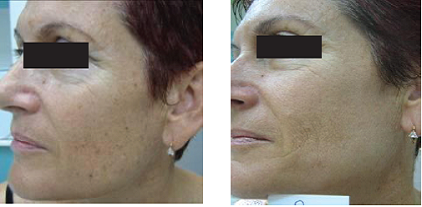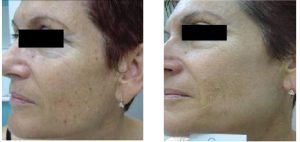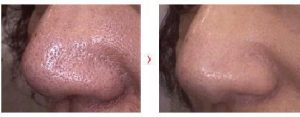CONTACT US

Skin Photo Rejuvenation with the SharpLight DPC Technology

B. Czajkowsky, M.D.1 , V. Kipnis, M.D.2
1SharpLight Medical Advisor, 2 AML Clinics, Israel
ABSTRACT
Pulsed light technology improves the texture and appearance of skin affected by age, sun exposure and environmental pollution.
The recent rapid growth in non-ablative, aesthetic, light-based treatments has led to an increased demand for platforms that treat a range of skin conditions, such as pigmented lesions/vascular lesions removal and textural imperfections.
Non-ablative pulsed light treatments are effective for all age groups and all skin types.
This paper documents our preliminary experience in performing skin photo rejuvenation on 30 patients with the SharpLight Platform, equipped with 535 nm and 580 nm hand pieces.
INTRODUCTION
Non-ablative skin rejuvenation has become popular with patients seeking no downtime procedures.
The theoretical basis of skin photo rejuvenation lies in the theory of selective photothermolysis combined with the phenomenon of neocollagenesis which occurs in response to a mild thermal injury in the reticular and papillary dermis.
The Formax/OmniMax SR 580 nm hand piece is designed for the treatment of skin textural damage: fine lines and medium wrinkles, open pores and dull skin condition.
The Formax/OmniMax VP 535 nm hand piece is designed for superficial pigmented and/or vascular lesions removal and can be combined with the Formax SR 580 nm hand piece.
VP is indicated for:
– Pigmented skin damage such as solar/aging lentigo/lentigines (brown spots), dyschromias and melasma.
– Vascular skin damage such as telangiectasias, erythema, rosacea, broken capillaries and poikiloderma. The treatment is commonly applied on the face, neck, chest, arms and hands.
The new intense pulsed light (IPL) platform system incorporates two technological advances: Dynamic Pulse Control and Skin Contact Cooling.
Dynamic Pulse Control (DPC) was developed to allow the practitioner to optimize the light pulse configuration for each particular clinical situation, based on individual patient skin characteristics and specific dermatological lesions. DPC enables the practitioner to maximize clinical effect while minimizing adverse side effects.
Three different pulse configurations are offered by the DPC: Smooth pulse, Long pulse and High pulse:
– Smooth pulse: delivers a square pulse (single continuous peak) with a slow tissue heating effect. Is indicated for skin textural damage on skin types I to V and big, dark P/V lesions.
– Long pulse: delivers a train of pulses at medium height peak and 50% duty cycle (50% on, 50% off). Is indicated for skin types I to IV on medium pigmented and vascular lesions.
– High pulse: delivers the most aggressive train of high peak pulses. Is indicated for skin types I to III on lighter pigmented and vascular lesions.
Contact cooling was developed to prevent epidermal secondary effects such as burns, by maintaining temperature of the epidermis at a low level throughout the treatment. Based on a thermoelectrically cooled sapphire window, the contact skin cooling of the Platform maximizes patient safety, reduces pain and provides better
patient comfort, yet allows the practitioner to deliver higher light fluences for increased clinical efficacy.
These technological advances of the Platform lead to better, safer and faster clinical results thus enhancing patient satisfaction.
MATERIALS AND METHODS
Platform main features for skin photo rejuvenation:
– SR 580-950 nm yellow hand piece
– VP 535-950 nm green hand piece
– DPC: Smooth, Long or High Pulse Configuration
– Pulse duration: 10-12-15-20 and 25 msec
– Spot size: 6.4 and 1.5 cmA?
– Fluence range: Formax up to 22 J/cm2 (6.4 cm2) and up to 30 J/cm2 (1.5 cm2) and OmniMax up to 25 J/cm2 (6.4 cm2) and up to 30 J/cm2 (1.5 cm2)
– Sapphire/Peltier Contact cooling
Treatments were conducted at the American Laser Clinic, Rishon Le Zion, Israel.
Thirty (30) female subjects aged 35 to 65, with skin types II to IV, were subjected to 4 treatments spaced 4 weeks apart. Subjects were followed- up 48 hours after each treatment to assess immediate effects and any potential complications, and 1 month after the last treatment to evaluate results and patient satisfaction with the procedure. Subjective clinical improvement was assessed by the physician by comparing pre- and post-treatment photographs and by the patients by assigning a
grade of 1 to 5, 1 indicating no result and 5 indicating an excellent result.
Prior to treatment patients filled a medical history form and signed a consent form and were questioned to rule out any contraindication to intense pulse light treatment. Contraindications include tanning of the area within the past 3-4 weeks, use of Accutane within the past 6 months, history of hypertrophy scarring or keloid formation and any skin condition or medications with sensitivity to light. A history of herpes requires use of prophylaxis prior to treatment.
A test spot was first performed on an adjacent area to determine optimal fluence, pulse duration and pulse configuration parameters that would result in mild, diffused erythema and edema without any adverse effect. Pigmented lesions should darken almost immediately and will exfoliate within a few days while vascular lesions may disappear immediately. Skin texture overall appearance should improve within 1 hour, resulting in mild erythema and mild edema that will give a skin replenishing glowing look. For darker skin types a waiting period of 24-48 hours is recommended to avoid an unexpected delayed response. Once optimal treatment parameters were determined, on a totally clean skin surface, two passes were performed over the face and hands area and a single pass over the neck and chest areas, per session. The light guide should float gently over the skin, without any pressure.
Typical initial treatment parameters for light skin patients were; Smooth to Long Pulse, 10 msec at a fluence of 15 J/cm2 , while for darker skin patients these were; Smooth Pulse, 25 msec at 10 J/cm2. Pending individual patient response treatment parameters were adjusted to be slightly more aggressive from treatment to treatment.
RESULTS
On the majority of patients (90%) a subjective skin clearance rate of 70% to 90% was assigned by the treating physician.
These results were in line with expectations based on published pulsed light photo rejuvenation results. In some patients results were above expectation possibly due to the new Pulse Form technology incorporated in the Platform system.
Adverse effects were limited to marked erythema in only 2 patients (6%) and resolved spontaneously within a few days. No hypo- or hyper-pigmentation or any other complications occurred.
Final results:
– 27 patients had positive subjective results of 70 to 90% skin improvement
– 3 patients had positive subjective results of around 50% skin improvement
Side effects:
– 2 patients (6%) with skin type IV had marked erythema that lasted from 2 to 5 days.
Patient Satisfaction:
– 27 patients were very satisfied
– 2 patients were satisfied
– 1 patient was not satisfied
Typical results are shown in Figs 1-3.
Figure 1. Textural damage and solar pigmentation (lentigines)
Before 4 weeks after one treatment
Figure 2. Textural skin damage and solar pigmentation (lentigines)
Before 4 weeks after 4 treatments
Figure 3. Textural treatment for open pores
Before 4 weeks after 3 treatments
CONCLUSIONS
Our initial experience with the new Platform for skin photo rejuvenation resulted in a high satisfaction rate in the majority (90%) of the patients.
In cases of pigmented and vascular lesions a subjective skin clearance rate of between 60% to >80% was assessed by the treating physician. There were no adverse effects nor any serious or permanent complications encountered throughout the treatment sessions, apart from 2 transient cases of marked erythema (6%).
The expected skin reaction of diffused erythema and mild edema appeared in 90% of the cases.
A high level of safety and comfort was noted by the patients as well as high practitioner confidence in the machine. Safety and low complication rates associated with Platform pulsed light skin rejuvenation is of particular significance when treating dark skin. It is concluded that Platform photo rejuvenation can be the basis for safe and effective skin rejuvenation in even darker skin patients but this has yet to be confirmed.
DPC advantages:
– Controls the "aggressiveness" of light energy delivery
– Allows optimization of clinical treatment parameters to maximize effectiveness, while minimizing risk to patient's skin
– Increases system effectiveness for a broader range of skin types, while maintaining a high level of safety
– Assures effective SR results on a wider variety of skin textural aging and sun damage effects, pigmented and vascular lesions
Contact cooling advantages:
– Safe use of higher fluencies for higher effective treatment
– Reduced number of treatment sessions
– Increased safety and patient comfort
– Reduced pain during treatment
Our clinical results with the Platform system are similar was previous international publications describing the use of intense pulsed light for the treatment of skin photo rejuvenation and superficial vascular & pigmented lesions removal.
High patient satisfaction, as found in our study, was noted in those published clinical studies, indicating good results in more than 90% of patients.
In our experience the new Platform system demonstrates same clinical efficacy and safety in reducing pigmented sun damage and vascular irregularities as well as textural damage. Proper patient selection and critical diagnosis serves to keep adverse effects to a minimum.
SUMMARY
IPL photo rejuvenation has become the modality of choice for many patients seeking a noninvasive, no- downtime aesthetic treatment for signs of aging or sun-damaged skin. SLT Platform with DPC technology and skin contact cooling, in combination with the VP 535 & SR 580 nm hand pieces appears to be an excellent system for safe and effective performance of these procedures.
Initial experience on 30 female patients resulted in very high satisfaction rates with no serious or permanent adverse side effects. The practitioners who are experienced with other IPL systems were highly impressed and satisfied with the new technological features incorporated in the SLT Platform system. In addition to assuring safety and efficacy, the system was found to be easy and convenient to operate, simplifying and shortening the processes.
REFERENCES
Adatto MA: Photorejuvenation of the forearms by treating hyperpigmented lesions with intense pulsed light source: a case report, Journal of Cosmetic and Laser Therapy, 2003 Jun; 5(2):117-9
Bitter PH: Noninvasive rejuvenation of photodamaged skin using serial, full-face intense pulsed light treatments. Dermatol Surg. 2000 Sep;26(9):835-42; discussion 843
Bjerring P, Clement M, Heickendorff L, Lybecker H, Kiernan M: Dermal collagen production following irradiation by dye laser and broadband light source. Journal of Cosmetic Laser Therapy 2002; 4(2):39- 43
Brazil J, Owen P: Long-term clinical results of photorejuvenation. J. Cosmet. Laser Ther. 2003 Dec; 5(3-4):168-74.
Dierickx CC, Anderson RR: Visible light treatment of photoaging. Dermatol Ther. 2005 MayJun;18(3):191-208
Fodor L, Peled IJ, Rissin Y, Ramon Y, Shoshani O, Eldor L, Gaiman A, Ullmann Y: Using intense pulsed light for cosmetic purposes: our experience. Plast Reconstr Surg. 2004 May;113(6):1789-95
Goldberg DJ, Cutler KB: Nonablative treatment of rhytids with intense pulsed light. Lasers Surg. Med. 2000;26(2):196-200.
Goldman MP, Weiss RA, Weiss MA: Intense pulsed light as a nonablative approach to photoaging. Dermatol Surg. 2005 Sep;31(9 Pt 2):1179-87; discussion 1187
Hedelund L, Due E, Bjerring P, Wulf HC, Haedersdal M: Skin rejuvenation using intense pulsed light: a randomized controlled split-face trial with blinded response evaluation. Arch Dermatol. 2006 Aug;142(8):985-90
Kligman DE, Zhen Y: Intense pulsed light treatment of photoaged facial skin. Dermatol Surg. 2004 Aug;30(8):1085-90
Laury D: Intense pulsed light technology and its improvement on skin aging from the patients' perspective using photorejuvenation parameters. Dermatol Online J. 2003 Feb;9(1):5
Negishi K et al: Photorejuvenation for Asian skin by intense pulsed light.Dermatol. Surg. 2001 Jul;27(7):627-31; discussion 632.
Ross EV, Smirnov M, Pankratov M, Altshuler G:, Intense pulsed light and laser treatment of facialtelangiectasias and dyspigmentation: some theoretical and practical comparisons. Dermatol Surg. 2005Sep;31(9 Pt 2):1188-98
Sadick NS, Weiss R, Kilmer S, Bitter P: Photorejuvenation with intense pulsed light: results of a multicenterstudy. J. Drugs Dermatol. 2004 Jan-Feb; 3(1):41-9.
Sadick NS, Weiss R: Intense pulsed-light photorejuvenation. Semin Cutan Med Surg. 2002 Dec;21(4):280-7
Weiss RA, Weiss MA, Beasley KL: Rejuvenation of photoaged skin: 5 years results with intense pulsed light of the face, neck and chest. Dermatol. Surg. 2002 Dec;28(12):1115-9








